Text



Fake yourself as human.
770 notes
·
View notes
Text

I write stories and to combat my ever growing number of plot bunnies, I create the main protagonist in art and by then, the idea is vanquished, silenced, never to return. Thusly, I can return to my original work and continue uninterrupted.
I am fond of eldritch beings, especially when they wear such an immaculate disguise to walk among mortals. What do you think?
Would you be interested in having an Eldritch Creature in your story? PM me and let me know.
#digital art#digital drawing#artists on tumblr#my art#art#drawing#eldritch#monster art#illustration#shirtless guy#tattooed#back tattoo#tattooed guys#monstruous reflection#mirror#reflection#true form in mirror#human disguise#constellations#furniture
17 notes
·
View notes
Text

I write stories and to combat my ever growing number of plot bunnies, I create the main protagonist in art and by then, the idea is vanquished, silenced, never to return. Thusly, I can return to my original work and continue uninterrupted.
I am fond of eldritch beings, especially when they wear such an immaculate disguise to walk among mortals. What do you think?
Would you be interested in having an Eldritch Creature in your story? PM me and let me know.
#digital art#digital drawing#artists on tumblr#my art#illustration#art#drawing#eldritch#monster art#human disguise#shirtless guy#tattooed#back tattoo#tattooed guys#furniture#mirror#reflection#monstruous reflection#true form in mirror#constellations
17 notes
·
View notes
Text

Scythe Model: Arrowhead
An interceptor-fighter craft known for its speed and unique style of combat that had made it the bane of all Imperial attempts at air superiority. The Arrowhead Model is specialized for Aeronautics combat, while its much larger and heavily armed variant, the Viper, is specifically constructed as an orbital fighter.
General Design:
Shaped like a leaf, the Arrowhead is quite small for an aircraft, not even nine meters long, with a width of three meters, its small profile makes it a challenge to target, especially when its right up in your face about its deadly intentions. Yet its proportions hide a surprisingly sturdy frame, on top of having a passive sensor mask that makes it very challenging for standard targeting equipment to get a lock on it or detect their approach until they are almost on top of its target.
Propulsion and Manoeuvrability:
The Arrowhead Scythe is propelled by six thruster engines at its caudal side that are not too dissimilar to the design of the plasma thrusters on void ships, if only with a much smaller profile. Furthermore, it is aided by grav-plates to remain suspended in the air without the need of wings to support its flight. However, these are not the most outstanding features of this craft, those would have to be the Gyroscopes.
Mechanicum adepts are still in heated debates as to the inner workings of recovered pieces of the Gyroscopes, as they have been dubbed, from dead Arrowhead craft. But what they all agree upon its that they are the singular most fundamental piece in the Arrowhead’s near physics defying agility.
Named after the device they most closely resemble in appearance; it is theorized they emit some form of gravitational anchor point that allows the craft to always be relative in their positioning to the closest primary gravitational well.
This is how the Arrowhead is able to remain in stable flight and turn without the need of any form of wings, as well as perform manoeuvres that would otherwise kill an organic pilot within. For instance, by simply rotating both Gyroscopes inside the Arrowhead in the same direction along a horizontal plane, the craft immediately spins on its axis without changing direction, allowing it to suddenly turn around on a pursuing target and light it up with its main armament before reconfiguring its trajectory back into a stable flight configuration.
For this reason alone, the Arrowhead has earned the righteous ire and fear of all Imperial pilots who have ever faced them in battle and survived to tell the tale.
Weaponry:
Arrowheads are a significant threat to face in combat, made all the deadlier by their arsenal.
Primary Weapon: Arrowheads maintain their weapons locked beneath their plating when in cruising mode or whenever they are performing their most famous attack. Depending on the Sub-Model of the Arrowhead, one could either expect forward facing twin linked las-cannons with surprisingly high rates of fire or a missile volley, ranging up to ten fire-and-forget missiles before the craft needs to fabricate replacements.
Secondary Weapon: Arrowhead Scythes all tend to be fitted with a secondary weapon on its underside, usually geared for smaller targets like infantry. These weapons tend to vary greatly from direct energy weapons like Laser Beamers and Volkites, or kinetic weapons such as RCGs.
Power Field Blade Wreathe: The most famous weapon of the Arrowhead, even if it’s the one with least range, if only due to the sheer gal of the Men of Iron to create a fighter craft specialized for melee.
Given its sturdy design and high manoeuvrability, the Arrowhead is designed to ram against enemy aircraft to immediately achieve a kill or shatter formations, forcing a chaotic dogfight where the Arrowhead holds the advantage or is actively forcing enemy craft to focus on it while other aircraft deal the finishing blow.
This final armament converts the Scythe into a flying Power Blade capable of slicing clean through a Lightning Strike Craft without hardly loosing speed, and given its agility, entering close quarters combat with these crafts is always a deadly dance where one wrong move could result in a swift end by the reaper’s blade.
#digital art#digital drawing#artists on tumblr#my art#art#pixelart#drawing#pixel art#pixel illustration#concept art#weapon design#sci fi#scifiart#aircraft#fighter plane
9 notes
·
View notes
Text

Also named as the Universal Gun, for its flexibility on the battlefield, it is considered the standard weapon of choice for the various groundside Man of Iron battle constructs in the Legion Armada.
Given its use of Repulsion fields in exchange of magnetic rails, it is able to make use of anything as ammunition, provided it has mass to affect and repulse. Everything from metal to plastics to plain gas can be utilized with this weapon, granting it immense tactical flexibility that the Imperial Bolt Gun would simply lack. The repulsion field can further be modified to fragment a slug as it travels through its terminal point or be used as a short-range repulsion field that can knock enemies off their feet or even contain them with constant repulsive force.
However, this is not the limits of the RCGs, as their second greatest trait is their modularity. Each Coil is an independent component that can be removed or added to reconfigure the weapon for various purposes, permitting the RCG to be converted from an assault rifle to a grenade launcher and then into a sniper rather quickly in a pinch.
Ammunition Forms:
Depending on the RCG and the Fabricator Feedstock its being used, it would fire solid heavy metal slugs or pellets, bolters and special fluid types.
Solid Metal Projectiles. Given that they are much faster to produce, they tend to be quite common and RCGs making use of these have shown a much higher rates of fire. Do not underestimate the power of these basic rounds, for more powerful Infantry Grade RCGs can fire a ferromagnetic slug with enough force to punch a wide hole through the resilient armour of Astartes with surprising ease.
Reactive Liquids. While they tend to not be as commonly employed, reactive fluids have found their place within the army of the Men of Iron. Given the Repulsion Field's ability to affect anything with mass, RCGs made to fire a steady stream of reactive liquid have their uses. From searing Promethium to Pyrocaustic Substances and the horrendously deadly Graywash [The Man of Iron's term for Nanites], they should not be underestimated.
Ferrum Bolts. While indistinguishable at a glance from standard Imperial Bolts, Men of Iron Bolts are much more compact and as a result are superior to their Imperial counterparts, possessing far greater range, speed and payload, and oftentimes capable of surprising tricks to increase their tactical flexibility. The following is the general list of Ferrum Bolts encountered by the Imperium by the end of the Razing of Prospero.
1(a): Standard Round and their General Sizes [Top to Bottom].
Heavy Bolt
Standard Bolt
Light Bolt
1(b): Special Munitions (Any Size)
Bio-Chem Round: Ranging from neurotoxins to pyrocaustic acids, the Bio-Chem Round is the catch-all term used for RCG Rounds that make their kill through the application of deadly chemical compounds or lethal pathogens. Its most common form is with the use of the Acid-KLR.7, an extremely deadly acid compound that releases hazardous fumes into the air once it begins dissolving matter. Rarely used unless for clearing out organic targets in confined spaces like Hive Networks and Ships, provided that they are used without the worry about civilian casualties.
Wailing Glass Round: A type of Psi-Round made from a synthetic version of the Shimmering Glass of the Reflecting Caves from Prospero. Bolts made with this material contain a heavy impact core energized with traces of Empyrean energy that does great damage to Metaphysical creatures like Daemons. Requiring a special Fabricator to be installed on the unit that intends on firing them, they are easily felt by psychically sensitive creatures for the 'wailing' sound they make as they travel through the atmosphere.
Tactical Round: Further modified Bolt, it is the general designation for Bolts designed for specific tasks in mind. Scatter Type explode mere meters away from a target, causing a shotgun like effect of heavy metal pellets to flay the flesh off their target. Ideal for Light Infantry. Hunter Type are able to make fine course corrections mid air to hit their target with increased accuracy or focus on weak points. Tend to be used for well armoured high-speed targets like Astartes. Restrain Type are light bolts filled with an adhesive and rapidly expanding foam. Used when wanting to incapacitate a target from afar with minimal chances of harming it.
Melta Round: A modified base round that is used mainly against Heavy Infantry and Light Vehicles. It is considered little more than a hybrid between a Bolt and a Melta Charge, yet this demonstrates the Men of Iron's ability to miniaturize advanced technology and mass produce it to a frightening scale.
Nanofluid Round: Made with killing Astartes in mind, it fills the role of a bioweapon designed to eliminate organic targets with an Immunity Rating of 7 and higher, whereas conventional bioweapons would be rendered either ineffective due to the aforementioned immunity or because non-combatants could also be afflicted with them should a bioweapon spread occur. It kills its target by injecting them with short lived Graywash fluid that rapidly shred the internal organs of its victim until all that remains is a darkened liquefied bloody paste, guaranteeing a swift yet very painful death on its target.
1(c): Heavy Special Munitions (Heavy Round Minimal Size Requirement)
Piker Round: Piker Rounds are made to penetrate deep into armour thanks to a Power Field that assists in perforating through vehicle armour with ease and detonating within. Made for taking down vehicles and extremely armoured heavy infantry like Terminators with a handful of shots.
Bullhead Round: Seismic-Grav Impact, made for causing as much damage to structures and heavy vehicles as possible, but limited to the higher-end weight class of RCGs. Upon impact, it releases a gravitational pulse combined with a singular, high-intensity shock wave that is capable of turning ferrocrete blocks into fine gravel.
Lumina Fluid Round: A Bolt Round exclusive to one Specialized RCG. Lumina Fluid is an extremely volatile and unstable psi-reactive substance that requires extensive security mechanisms to safely create and contain. It is oftentimes described as having the worst aspects of raw Warp Energy and Nitro-glycerine combined into the most frighteningly unstable Psi-reactive compound in the Man of Iron's army. As such, Bolts made to contain this Fluid require a miniaturized Stasis Field to avoid an unwanted pre-detonation. When they strike, however, the target is subjected to a miniaturized and explosive Empyrean detonation that no material armour can resist. However, their true target is the Metaphysical organisms that exist within the Warp, as being struck by such a weapon would critically injure even Exalted Daemons.
-Standard RCG Models- {2}
a) Crisis Pistol: Small sidearm for the Peacekeepers. Used mostly against infantry or to deliver specialized ammunition fire.
b) Tri-Angled Modded Crisis Pistol: Due to a quirk in the Repulsion Fields, creating something like a minigun is unfeasible. Instead, high fire rates are achieved by multiplying Repulsion Coil Barrels into a single weapon.
c) Principality Assault Repulsion Rifle: Standard RCG used by most Peacekeeper models.
d) Flamer Modded Principality Repulsor: A modification of the Principality Repulsion Rifle for dispensing a stream of Promethium.
e) Principality Adapted Granade Launcher: Heavy barrelled grenade launcher, capable of fabricating and launching specialized grenade ammunitions at a rapid pace.
f) Providence LMG: Large and heavy hitting firearm, used exclusively by Knights and Paladins. Excellent for eradicating anything in their path.
g) Providence Adapted Sniper Gun: Capable of taking down heavily armoured targets up to seven kilometres away or even further if aided by course correcting ammunitions.
-Specialist RCG Models- {3}
Specialist RCGs are all named in a long-forgotten tongue of Man. For whatever reason, the Man of Iron bears a fancy for ancient unspoken languages.
A) Canto de Dante: To the untrained eye, this RCG may seem like a mere Combi-weapon given its ability to fire both searing beams of molten metal and discharge short range blobs of plasma, however, that could not be further from the truth. Making use of the comparatively most powerful Repulsion fields in union with a component that bears many similarities to the Volkyte systems, it is able to fire a condensed beam of superheated metal at its targets. However, this system bears great flexibility, for it can also heat the very metal inside the containment chamber until the point it becomes a searing glob of barely contained heavy plasma that then gets discharged at close range in a wide cone capable of melting through any target. While the Magnetohydrodynamic beam struggles to penetrate thicker armour at range, the ionized metal discharge up close will succeed where the former fails.
B) Lagrimas de Lilith: Only weapon permitted to fire the infamous Lumina Fluid Round. While internally it is not that dissimilar from a standard medium RCG, its fitted with an E-Injector for charging the Lumina Fluid that it uses, as well as Stasis Field Projector. Externally, it is protected with thick plating to protect the very fragile and volatile components within. However this volatility is also used as a feature in certain cases, as Lilith's Tears can be turned into an impromptu Warp Bomb capable of turning even heavy tanks into a heap of Empyrean Warped metal and screaming scrap.
C) Gota Negra: Specialized weapon designed for producing and dispersing Graywash fluid in various. Its main form of attack is to fire Nanofluid Rounds, yet that is not the limit of its power, for it has three settings to diversify its lethal arsenal, by either releasing a stream of Graywash in a thin condensed jet that breaks down matter and tissue, or disperses clouds of microscopic particulates that are exceedingly dangerous to walk through unprotected, much less inhale.
D) Martillo Esmeralda: Specialized RCG that is less a gun and more a Seismic-grav Thunderhammer with a RCG Barrel and fabricator attached to it. So large and heavy that only Paladins are known to be able to properly wield them, it is in their hands an impossibly agile weapon as the device can regulate its own gravitational mass, capable of tipping over light armour as if they were mere toys with every hit and levelling buildings with frightful ease.
Author's Notes: Okay, I think I went a bit overboard. I have grown a whole new level of respect for concept artists. Phew...
I was meant to do the drawing for the Scythe, but since I already had these weapons in my prior drawing I decided to recycle the used assets and make this before moving onto the fighter jet... little did I know that my urges to make something as high quality as possible resulted in me just adding one too many shootas... sweet god... anyway, I hope you enjoy. Next weapon sets will be the Direct Energy types.
#digital art#digital drawing#artists on tumblr#my art#art#pixelart#pixel art#scifiart#scifi#firearm#weapon design#concept art
6 notes
·
View notes
Text

Infantry Class Tactical Unit: PEACEKEEPER
Models: Assassin, Squire, Knight, Paladin and Bishop
#digital art#digital drawing#artists on tumblr#my art#illustration#art#drawing#pixelart#pixel art#pixel aesthetic#sci fi#robots#robot art#mecha art#weapons
5 notes
·
View notes
Text

Peacekeeper Knight, by AEngel-07.
Real happy how this one turned out. My first pixel art! yay!
#digital art#digital drawing#artists on tumblr#my art#art#pixel art#pixelart#scifi#science#robot art#mecha#mech
25 notes
·
View notes
Text

Legion Engine: Commander Frame
#digital art#digital drawing#artists on tumblr#my art#illustration#art#drawing#mecha#science fiction#scifiart#scifi#robot#mech#dark aesthetic
64 notes
·
View notes
Text

Prospector Drone
#digital art#digital drawing#artists on tumblr#my art#illustration#art#robot art#robotics#sci fi#science fiction
11 notes
·
View notes
Photo

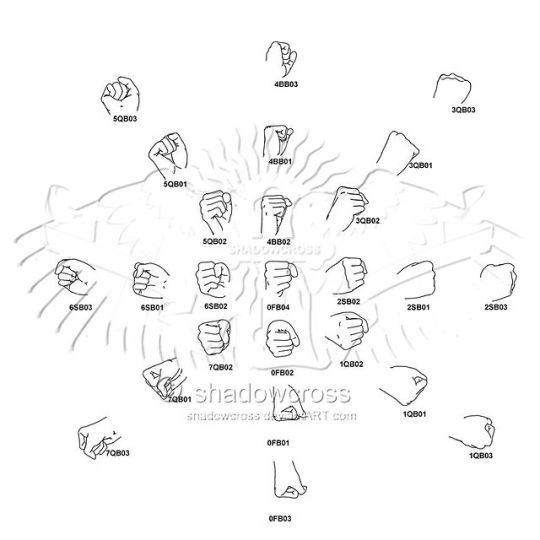



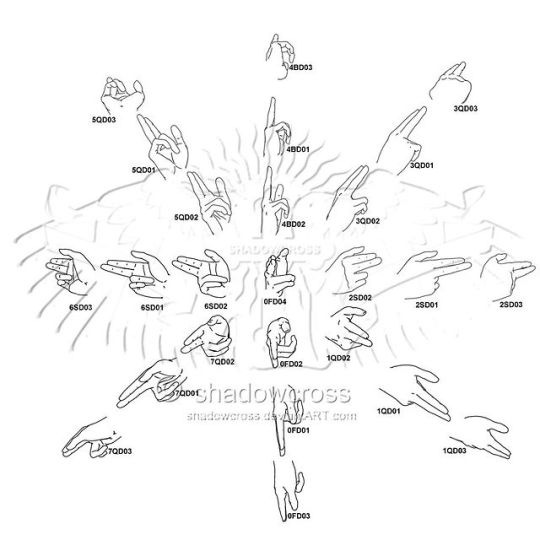
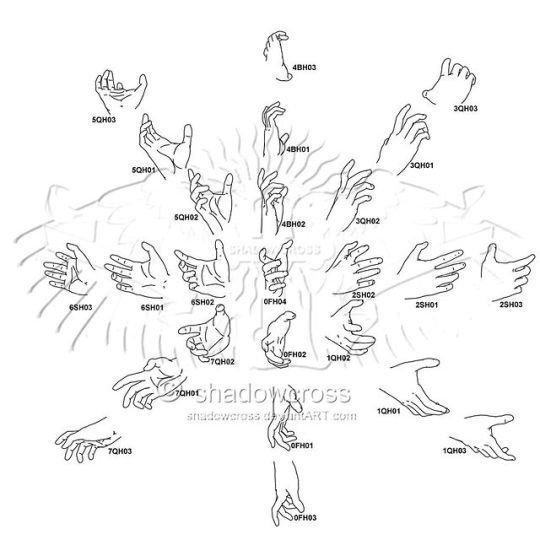

A mouth-watering fuck-ton of hand angle references.
By Shadowcross on DA.
258K notes
·
View notes
Text

Commission: Prometheus
#digital art#digital drawing#my art#artists on tumblr#illustration#art#greek mythology#greek gods#greek titans#prometheus#greek art#hercules#completed commission#commission#art commisions
5 notes
·
View notes
Text

Commission: Prometheus
#digital art#digital drawing#artists on tumblr#my art#illustration#art#greek mythology#greek gods#greek art#greek titans#prometheus#hercules#completed commission#commission#art commisions
5 notes
·
View notes
Text
Falmer appearance and attire headcanons
(click on drawings for more details and notes!)
Hair
In Skyrim, we pretty much only see two hair styles to go off of: completely bald and the hair the "shaman" have (which are also the only females we see (a post for another day)).
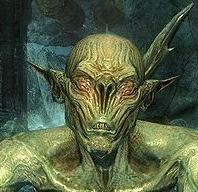
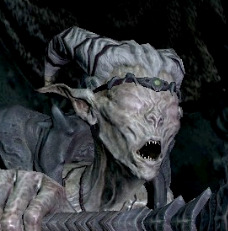
In concept art, particularly Adam Adamowicz's, we see more potential hairstyles. He draws it as wispy and messy, as well as containing braids and the ties we see in the shaman in the game. This art is largely what defines my own interpretation of their hair.


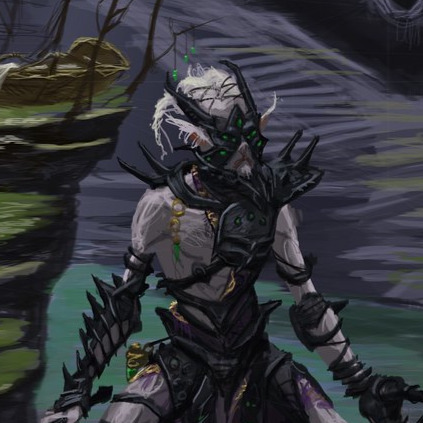
I picture the typical Falmer hair as wavy, thin, wispy, and looking frizzy. Given the high number of hairless Falmer we see, I imagine baldness is common, particularly among males, and sometimes among females. Their hair can be commonly styled into braids or knots to keep it under control.
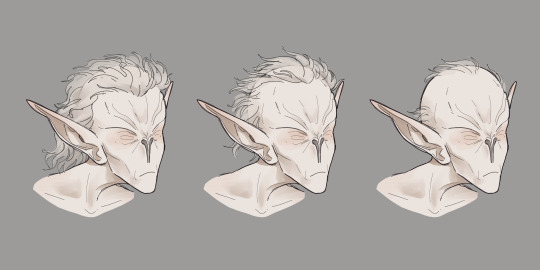
The ability to grow long, thick hair is less common, but those who can tend to style it in other unique ways. Especially among females, long hair is commonly styled into large dense locs (akin to a Polish plait) and held into shapes using ropes or leather ties.

(While I think the intention with the way their hair is drawn and modelled in the game models and concept art was that it was braided and held up with those ties, before looking at it closely I always sorta interpreted it as too stiff to just be braided. As a result, I developed the locs headcanon and have become kinda attached to it even though I have 0 in game or lore support for it)
Materials
The material used in their clothing is obviously dependent on what is accessible to them, and given their unique situation that makes the materials they use and value unique as well. In Skyrim, we see that almost all of their armor (which is mostly what we see them wearing) and homes are made of chaurus chitin (and potentially shellbug chitin), so this is likely the most common resource available to them for non-combative coverings as well. Other materials from their arthropods companions could include their cocoons, unhatched eggs, etc.
Bones from other creatures (draugr, skeevers, trolls, adventurers, bandits, etc.) underground or from aboveground raids could also be used fairly often. These could also provide a source of leather or fur, albeit not a lot of it.
Falmer groups and subcultures inside or in close proximity to Dwemer ruins probably make regular use of the materials present in those ruins as well. With all the metal and machinery present in Dwemer ruins, metal probably makes regular appearances in their clothing (and general decorations) even if they can't manipulate it themselves. Falmer more separated from Dwemer ruins would make much lesser use of these materials, however. Additionally, We see implications of Falmer preparing, cooking, and potentially cultivating fungus in-game, but see nothing indicating they have any plants in their diet, and therefore it is unlikely they regularly make or use textiles or fabrics in their clothing, and if they do they likely come form Dwemer ruins or raided adventurers/bandits/settlements from the surface.
On that note, we know that there have supposedly been incidents of Falmer coming to the surface to attack its inhabitants and travelers, as well as instances of them killing bandits, adventurers, and researchers who venture below, so it's not far fetched to believe that they have access to some materials from the surface. This could give them some access to furs from surface animals, beads, glass, jewelry, textiles, metal objects, etc. they might not otherwise have access to. The rarity of these material among the Falmer would depend on the amount of access any given group of Falmer have to the surface, but among many of them these materials could be seen as more valuable for their rarity and the difficulty to gain them.
While gemstones and ore might be accessible from both natural deposits and underground ruins, unless they had some kind of auditory function or unique texture, they might not have much value to Falmer.
General Attire/Accessories
I like to imagine that the Snow Elves, and by extension the Falmer, have an innate cold resistance in the same way Nords do, and therefore don't require clothes for the purpose of warmth even in the chilly caves of Skyrim. Additionally, their blindness likely means that wouldn't dress for visual aesthetic either. My thoughts are that they are then left with the sense of sound and touch to communicate with each other, and their clothing and accessories could reflect that.
Falmer clothing, decoration, and society in general is very heavily based on touch and texture and little on appearances. They touch each other very often for both communication, movement, and just general day-to-day interactions, and their clothes isn’t very modest, but the tactile patterns and materials used can communicate certain things such as position in society, “wealth”/power, whether they are taken, single, pregnant, with a child, etc., their roles, their age, notable achievements/skills, who is who, etc. on both their clothes and buildings. The more noise one makes, the more attention they draw and the more they drown out other noises, and the more noise making things they can “afford” to have, so the amount of noise one makes in a Falmer settlement is a status symbol. Certain types of noises or noise makers are more coveted than others (chitin beads are common, while furs are less common, and materials only gained from raiding the surface are rare and coveted).
Some noise making accessories could include:
Dangling metal, bones, beads, chitin, etc. that hangs off of their clothing or ears and jingle/clank against each other (in my drawing I show them as pretty uniform in shape and size, but they would probably be much more irregular than I depicted them)
Bells (metal or other materials) that are affixed to or dangle off of their clothing or as earrings.
Hollow bracelets, anklets, necklaces, or other accessories that are filled with rocks or beads.
Rattles tied to the body (made of chitin, dried hollow chaurus eggs, dried chaurus cocoons, beads, etc.) with leather or rope.
Flute or whistle like tubes made of metal, chitin, or dried and treated tube-like fungus that makes a woodwind-esque noise when air passes through it in a certain way. They have been designed to make noise easily from even the slightest movements.
Dried grasses (more temporary) tied to the body that make a swishy noise. More permanently, a similar thing can be achieved with hair. The hair can be sourced from Falmer (either through just cutting hair or through taking it from fallen enemies) or killed humans/mer/draugr. That sort of thing can also act as a kind of trophy.
Necklaces with various materials dangling close together that jingle against each other.
Various materials can be tied into braids or the leather ties in their hair as well.
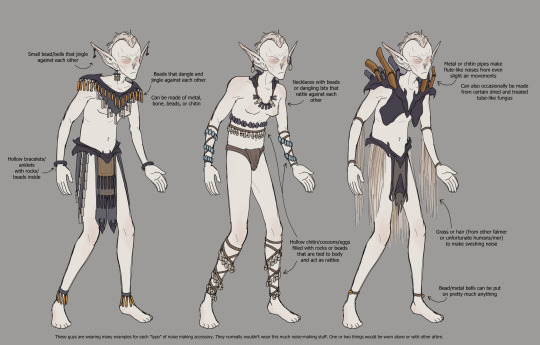
Some textural accessories could include:
Beads. Since they wouldn't have the ability to tell the color of the beads, the patterning of beadwork would be based on the roughness, material, size, or shape of the beads. (I'm sorry I suck as drawing beads)
Furs. This wouldn't be as common since the Falmer likely don't have too much interaction with furry mammals, but some they may have access to that are big enough to make clothing/accessories out of include skeevers or trolls (and potentially rarely animals from the surface). A potential meaning of wearing furs could be as hunting trophies, but it could have other meanings as well.
Chaurus chitin would like be the most common material in Falmer attire, and depending on the part of the chaurus body, the size of the chaurus, or the life stage of the chaurus it was sourced from it could have different textures. Some chitin parts could include large spikes and deep groves, while other parts could be smoother and less rough. The use of this chitin in clothing could take advantage of this contrast in textures. Additionally, chitin or shells from shell bugs might be a different texture from the chaurus chitin. (it's unclear to me whether shell bugs are exclusive to the caves around the Forgotten Vale or if we should consider them distributed throughout Skyrim's underground)
The placement of textured components on the body could have their own meaning to it alongside what accessories or textures are being used.
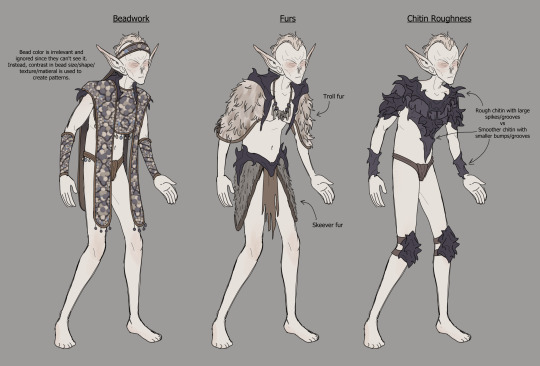
Specific Falmer Subcultures
While most Falmer settlements we see in Skyrim are just a small-ish collection of huts and chaurus corrals, there are two distinctive settlements that are larger, seemingly more organized, and I like to think have their own distinct subcultures worth mentioning: Blackreach and the Forgotten Vale. The unique scope and environment of these Falmer cities (as I like to think of them) could lend to unique clothing cultures as well.
The Falmer of Blackreach have access to a vast Dwemer settlement and have has the space to spread out throughout it more fully since it seems to be more in tact than other Dwemer ruins we see. These guys would likely have a clothing culture much more heavily based on what the can access from these Dwemer ruins (metal scraps, leftover fabrics, etc.)
The Falmer of the Forgotten Vale would also have access to unique resources, such as Vale deer, Vale sabre cats, and frost giants for fur and leather. Additionally, materials accessed from the Chantry of Auri-El such as textiles from clothing, bedding, tapestries, etc. could give them a greater access to fabrics than other Falmer groups. We don't see many close Dwemer settlements to the Vale, so they would have less Dwemeri influence in their clothing than other Falmer groups.
I like to think that the Falmer's evolution exclusively underground has made them poorly equipped to handle the outdoors during the day and has made them particularly susceptible to sunburn, necessitating the need for covering for those in the Forgotten Vale who have significant settlements outdoors. With greater access to textiles and leather, they could use them as coverings when outdoors.
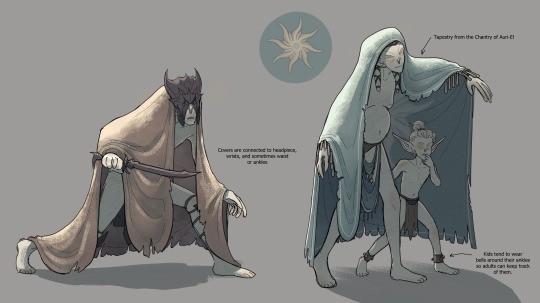
Armor
I actually have very few notes on armor, for two reasons. 1) I hate designing and drawing armor. It is the bane of my existence. 2) I really like the armor they have in game! I think they look awesome aesthetically, and I like how clearly they are made from chaurus chitin. Per usual, Adam Adamowicz's designs seem to have been the major inspiration for the Falmer armor, and he did a great jobs (even if it isn't the most functional looking armor ever).
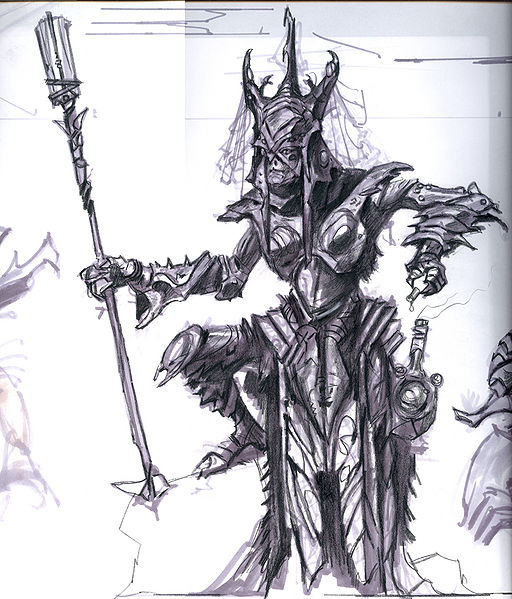
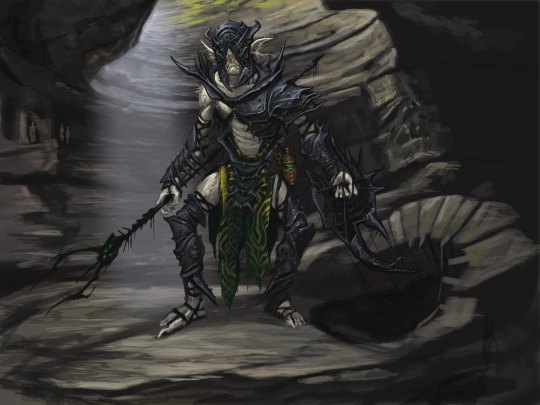

(off topic but I also just want to add that he draws them with little hairs and tufts on their ears and I love it. ok that is all)
I do have a few thoughts about armor though.
Even attire made of textiles make noise when someone moves in them, and I can imagine moving around in armor, especially armor made of hard, insect shells would make a lot of noise when someone moves around in it. When you're relying on sound to navigate your environment and pinpoint potential threats or targets, wearing something making a lot of noise would not be ideal. On the other hand, getting into a fight unarmored would be a problem.
So here's my solution: heavy armor (see below) would only be worm within the camps/settlements where noise was already high and space is more cramped (and therefore more risky in a fight) as a sort of guard in case they were attacked. Those guarding the settlements along the outside might still wear armor as well, but less of it. Those going out to scout or hunt (if they do hunt) would wear as little armor as possible, and try to wear it strategically so that it wouldn't rub against itself and make noise. This is why most Falmer we encounter in the game are wearing little except for loin cloths and kneepads.
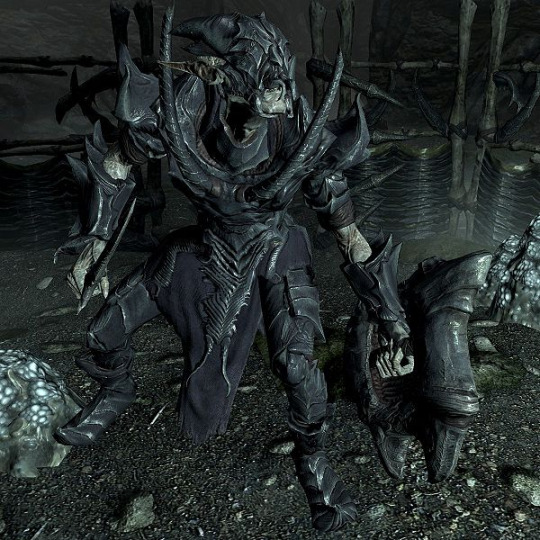

One more idea I have for armor is a specific armor piece. On the note of guarding or protecting a camp or settlement, I imagine the noises of it all (especially with the noise based headcanons I've laid out here) would make it hard to actually catch any potential threats when you can't see. A large slightly concave piece of armor worn behind the head could block out noises from behind the wearer, as well as a help focus sounds ahead of them.
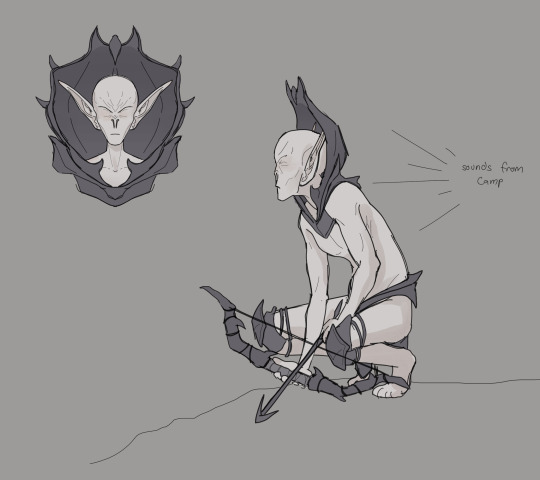
That is all! Thank you for reading! A lot of these concepts around the culture of sound I think could also be applied to their buildings and even a culture of music, but those are posts for another time.
All of the concept art I used was taken from here and all of the Skyrim screenshots are from UESP.
919 notes
·
View notes
Text

Commission Piece: Slaying of the Vampire Dragon
Commissions OPEN: https://ko-fi.com/albertaengel/commissions
#digital art#digital drawing#artists on tumblr#my art#illustration#art#commissions open#commission#commission art#completed commission#dragon art#xianxia#spirits
23 notes
·
View notes
Text

I have never drawn a creature made out of raging storm clouds... now I can boast that I have.
The Storm Dragon
#digital art#digital drawing#artists on tumblr#my art#art#illustration#storm#dragon art#fantasy creatures#creature art#dragon design#storm dragon#thunderstorm#lightning
17 notes
·
View notes
Text

Tree Colossus
Finally back to drawing so I am feeling quite happy how this one came out.
#digital art#digital drawing#artists on tumblr#my art#illustration#art#colossus#plant elemental#fantasy art#mythical creatures#mountains#sunset#seaside#clouds#cliffs
16 notes
·
View notes
